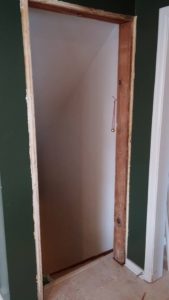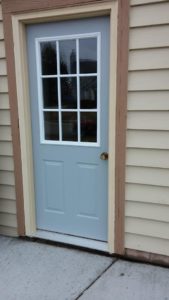Door Installation & Hanging | Milwaukee
We have installed hundreds of doors in homes throughout the Milwaukee area.
Give us a call to discuss your door installation or hanging needs.
Door Installation & Hanging FAQs
What is the difference between installing and hanging a door?
The difference between “installing” and “hanging” a door starts with the type of door. When you pick out and purchase a door, you have two options: pre-hung and slab. A pre-hung door is a door that comes already hanging in its own door frame. All hardware necessary to a working door is already installed except the door knob and strike plate. This self-contained unit is then “installed” in the wall.
In contrast, a “slab” door is the type that needs to be hung. A slab door is just what it sounds like – a slab of wood or other material in the shape of a door. This slab does not include hinges, a door frame, door knob, or any other hardware or features of a door; these need to be added later. Therefore, in order to turn the slab into a functional door, you will need to “hang” it in a frame.
What is the difference between a pre-hung and slab door?
A pre-hung door is a complete package, including a slab door with hinges already affixed in its own frame. The only pieces not included in most pre-hung doors are the door knob, strike plate, and any trim or materials needed to help the frame blend into the surrounding wall. Pre-hung doors are ideal for new construction homes, door replacement projects in which the frame has been irreparably damaged, and for exterior doors, as a pre-hung door is guaranteed to be weather-tight.
A slab door is the opposite; it’s a slab of wood or other material in the shape of a door. This slab does not come with any hardware or in its own door frame; the hardware needs to be installed separately and the door hung in a pre-installed frame. Slab doors installation is a much more difficult process, but slab doors can be better than pre-hung doors in certain situations. They are significantly cheaper, lighter in weight, and can be used in interior spaces without concerns about weather-tightness.
How do I pick out a door?
You have a lot of options when it comes to choosing a door, and what you choose largely depends on your style and how the door will function. For exterior doors (doors leading to outside your house), you can choose between steel, wood, or fiberglass material (with some variation). Within these three material categories are different finishes and require different levels of maintenance (none very much). The front door of a home truly sets the tone and, in some homes, can play a major part in the functioning of the ventilation system. That’s why we suggest taking your time choosing an exterior door and asking an expert.
Can I install a door myself?
Installing a door can be a complicated (and heavy) process, and installing an exterior door incorrectly can cause all types of problems, which is why we strongly suggest bringing in extra help.
How long does door installation and/or hanging take?
The amount of time it will take to install or hang a door largely depends on the project. Times can vary based on if we have to remove, replace, and/or build a door frame, the type of door you choose to install, and if structural issues with the home come into play. Normally, though, a single door installation or hanging takes less than one day.
How much does door installation and/or hanging cost?
The total cost of installation and/or hanging of a door largely depends on the situation. Factors such as whether we provide the door or you pre-purchase it and whether additional repairs need to be made to the frame will affect the cost. The best way to gauge how much your door installation or hanging project will cost is to ask. Give us a call today for a free estimate.
How should I prepare my home for a door installation?
Great question! Before we come to install your new door, please remove any curtains, blinds, or other treatments fixed to the current door. If applicable, please also contact your security company to have them remove or disable security alarms on the existing door (these can, of course, be reactivated/reinstalled once the new door is in place). Be sure to move or adjust any furniture or other items surrounding the project area so there is a clear path, and you may also want to take down hanging pictures from the wall surrounding the doorway. All of these measures will help ensure we do the best job possible with no accidental damage to your home and property.
Will the installation make a mess in my home?
No. Here at Best-Handyman, we take pride in providing excellent work and leaving your home even better than we found it.
How will the door installation affect the surrounding walls? Will I need to repaint after the door is installed?
We pride ourselves on our exemplary customer service. That includes showing great respect for the homes and properties we work on. We take every precaution to prevent damage to surrounding walls during a door installation project. If you are still concerned or have additional questions, we would be happy to speak with you.
Will Best-Handyman dispose of my old door?
Yes we can get rid of your old door.
Call to schedule a FREE in-home estimate.
Door Choices
The choices these days are endless and over the past few years the features that are available are also fantastic. Here are a few choices a homeowner may choose from.
Blinds inside the glass that can go up and down and also tilt, wood grain on the inside and custom paint on the outside, wide variety of stained or etched glass, weather stripping and threshold are part of the jamb, brick mold on the outside can be a plastic resin that will not rot, fiberglass or steel doors are available. There are even custom colored hinges! The prices are consumer friendly. These are just a few options that are available.
How to Measure for a Pre-hung Exterior Door
Before shopping for your door, you will need to measure the door you are replacing. Doors come in only a few sizes and are as follows: 24” x 80”, 30” x 80”, 32” x 80”, 34”x 80” and 36” x 80”. These are standard sizes, all other sizes are custom order. Next you need to measure the jamb width (The vertical portion of the frame onto which the door is secured through hinges). Standard size is 4 9/16 ”, 5”, and 6 ¼”. Next you will need to figure out the swing of the door, which simply means, which direction you are going to be opening the door. The easiest and standard way to know which you are using is to put your back against the INSIDE of the door and where the hinges are in relation to your hand, that is the swing. Example if the hinges are on the left side when your back is against the door then this would be a left hand swing. So the 3 things you need when ordering or picking out a door are door size, door swing and jamb width. So it would look something like this “36 x 80 Left Hinge door with a 4” 9/16 jamb.
For you DIYers, follow these 9 Steps to Replace a Door
- Take a razor blade knife and cut the paint next to the casing on the inside of the door and carefully remove the casing and save to reinstall later.
- Remove the door from the hinges by pulling the hinge pins and then take a sawzall and cut horizontally through both sides of the jamb but NOT cutting the 2×4 stud. Remove and make sure the 2×4’s are clean of debris and no drywall is hanging over if so cut it off flush.
- Take all the shipping material off the new door including a big black corkscrew in the lockset hole and disregard. Carefully insert the new door from the outside in, into the opening evenly spacing both sides by shimming at the hinge points and likewise on the lockset side. Then remove the screw in the hinges closest to the weatherstripping and replacing it with a 3” gold screw and screw through the shims into the 2×4’s. Do this on all 3 hinges and on the lockset side also making sure the margin around the inside of the door is the same, approximately 3/16”.
- Foam the entire gap between the door and the 2×4 with DAP Window and Door Foam.
- Nail the outside brick mold with finish nails and putty using DAP white ALEX caulk. Caulk exterior line between brickmold and siding/brick. Caulk bottom of threshold with a thick bead also.
- Install deadbolt and lockset.
- Re-install casing on inside using a finish nailer and pin gun.
- Apply a small bead of caulk next to casing on inside to stop any cold air from leaking in.
- Install a piece of stained wood on the inside threshold of door on the floor as a transition strip.
Best Handyman Services provides FREE personal labor estimates. These guidelines are helpful hints for installation and are not exact instructions. Best Handyman Services is not responsible for self-installed doors or adjustments that may need to be made.
Call to schedule a FREE in-home estimate.




